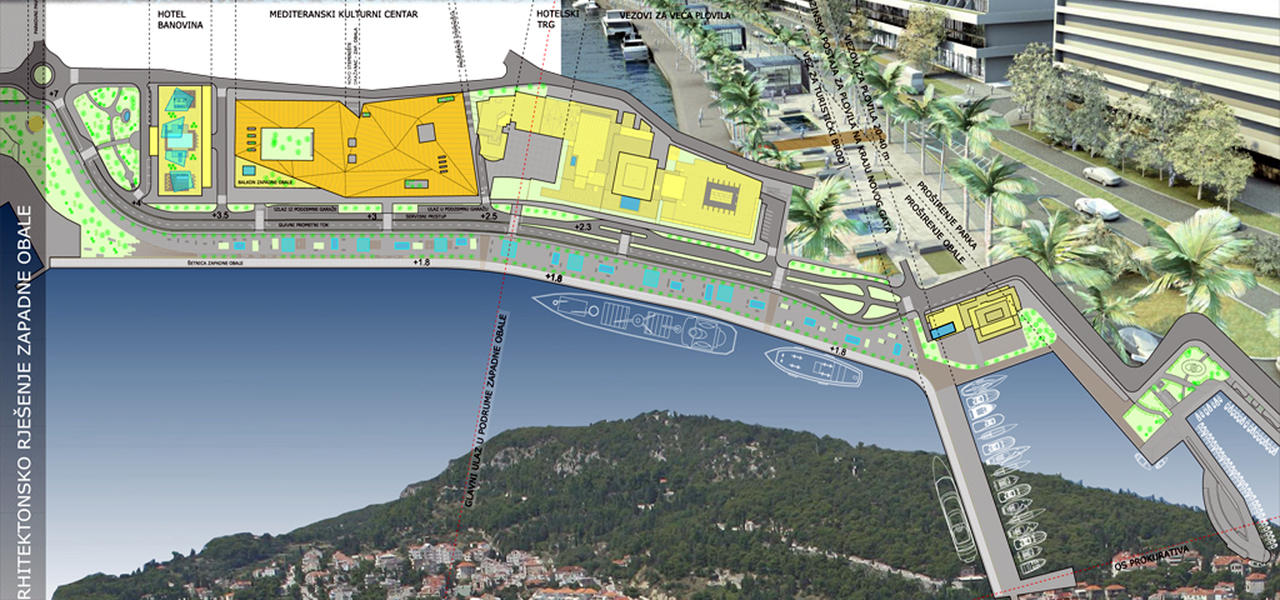
West Coast of Split
Status:
Project not implemented
Year of designing:
2010.
Program:
Competition, Urbanism
Location:
Braninirova obala,
show location on map
Authors:
Arsen Čupev, , Srđan Škunca, Vladi Bralić
Associates:
Kata Marunica, Nenad Ravnić, Vedrana Ljubić
What stands for the West Coast of Split? Is it the line where the Marjan Hill dives into the sea, the extension of the Riva (Split waterfront), or antipode of the eastern – travel coast, or maybe an independent spatial entity? The morphological, the functional, the formal and the temporal dimensions of the development of this area demonstrate the existence of each of the listed possibilities as determinating, all the while non excluding the impact of others (listed and non listed) characteristics for rethinking the development and the decorative strategies of this area as a whole.
In the challenging aspects, the development of Split on the segment of its west coast during the past 70 years has shown two patterns:
- Planning the area does not equal rethinking its purpose in the urban context:
- Implementing planned changes is in fact concentrated effort, and can at times even be impeding of development.
After finishing operations on Riva and Matejuška, however in light of unanswered questions about solving the contact surfaces, the noted as well as the marginal ones (drawings which must be the outcome of numerous research ranging from spatial-functional to matching them to an adequate communication matrix), this competition application features a concept of urban planning, functional directing and ground floor design built on the following principles:
- The West Coast represents the coastline extension of the Riva (Waterfront) because it enables reaching the farthest points of the waters positioned within the observer’s view range and within city core;
- Apart from decoration, the West Coast should be attractive for its contents. If the Riva represents an extend of the Palace (it leans on it and its identity derives from connection to the Palace), the West Coast should also possess at the very least, the elements of its own recognition;
- The West Coast should represent content extend of the Split city nucleus. Although what we are suggesting requires additional time, morphologically and typologically separate from the content matrix, we are still in the area of interesting characteristics which has some features and characteristics embedded to the point of iconic identification (Banovina, hotel Marjan, former city graveyard), and parts of this iconic mosaic are located even further (Meštrović’s Kaštelet, Museum of Archeological Monuments et. al.);
- The West Coast should represent a strike of recognition and memorability for its feature – view of the city waterfront. Split, as a city of frequent naval traffic, organized (lineal, chart etc.) as individual, should build on its attractive littoral city profile. If we discharge the verticals of the residential towers and lines (interesting by all means to those of profession, but sadly, anynonimous to the wider public), the steeple of St. Dujam Cathedral, the Green Cap of Marjan, life on the passenger port, and newly, an authoritative move on city’s Riva (seafront), we are left with only some of the views a visitor to the city experiences intensively;
- In this modern, Mediterranean city, a beach should by its offer, supply and relay of its contents be a space of (living) life 24-7.
Other projects from the category Competition:
- Pula Waterfront
- Theatre Park
- Sava Park, Remetinec and Tromostovlje
- Transformation of Kaptol
- Fountain Square in Buzet
- Krčki Tanac – A Memorial for the Victims and the Fighters of the National Liberation War
- Memorial Bridge for National Defenders
- Crystal Cube of Serenity for Tin Ujević
- Strmica Water Tower

